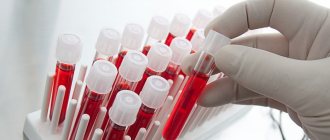With the help of prolactin, breasts form and grow (the hormone is also responsible for the development of ducts), and milk is produced after the baby is born. In addition, ovulation depends on prolactin. The hormone is involved in the regulation of progesterone production: its increase leads to a decrease in progesterone production and, as a result, to a slowdown in ovulation processes.
During pregnancy, prolactin levels increase significantly. This is a normal process. After childbirth, during lactation, it remains high (although compared to pregnancy, of course, it falls). This explains the very low chance of pregnancy during breastfeeding. But still, if the cycle is restored, breastfeeding cannot be considered a reliable method of contraception.
Outside of pregnancy, prolactin levels fluctuate depending on the day of the menstrual cycle. A strong and sustained increase that is not associated with bearing or feeding a child has a negative effect on the body. This condition is called hyperprolactinemia.
Norm prolactin in women
| Cycle phase | Normal prolactin concentration |
| Follicular (approximately 1-13 days) | From 4.1 to 30 ng/ml |
| Ovulatory (approximately day 14) | From 6.5 to 50 ng/ml |
| Luteal (approximately 15-28 days) | From 5 to 41 ng/ml |
The prolactin norm for expectant mothers and nursing women is much higher. The level of the hormone begins to increase in the first trimester and reaches its peak in the third. During this period, the normal concentration is up to 318 ng/ml. Moreover, even if the prolactin level goes beyond this limit, this does not indicate the presence of pathology. Pregnant women generally do not need to worry about these indicators.
What is prolactin
Prolactin is a hormone whose expression, along with luteinizing and follicle-stimulating hormones, occurs in the pituitary gland. This is a substance of polypeptide nature, the molecule of which consists of one hundred and ninety-eight amino acids and three disulfide bridges. It is secreted into the blood in small quantities. The hormone is released in a strictly defined daily rhythm, with its maximum amount in the blood occurring during sleep. At this time, its concentration is seven times higher than during the day.
Prolactin, by feedback principle, influences its own expression. It acts on the feedback principle on the cells of the hypothalamus and promotes the release of dopamine from them, which from the gray tuberous and paraventricular nuclei of the hypothalamus enters the pituitary gland and binds to receptors on lactotropic cells. Thus, not only the secretion of prolactin, but also gonadotropes is inhibited. When regulatory mechanisms are disrupted, women experience symptoms of increased hormone levels.
Two groups of factors are involved in the regulation of prolactin levels:
- inhibiting this process: GABA, dopamine, gastrin, somatostatin, gastrin-releasing peptide, as well as histidyl-prolyl-diketopiperazine;
- stimulating hormone production: thyroliberin, bombesin, serotonin and vasointestinal peptide, opiates, as well as luliberin and neurotensin.
Its secretion is enhanced by estrogens and thyroliberin. It also increases under the influence of nerve impulses from the nipples. Prolactin helps prepare the mammary glands for lactation, so its concentration in the blood constantly increases during pregnancy and becomes high in the third trimester. This is physiological hyperprolactinemia. When serum levels of the hormone become high outside of pregnancy, we speak of pathological hyperprolactinemia.
Elevated prolactin levels - symptoms, causes, consequences
The limits of the norm are quite wide for women who are not pregnant or breastfeeding. From time to time, prolactin may rise above the upper level, and this does not necessarily indicate serious problems in the body. The level of the hormone can fluctuate due to emotional stress, taking certain medications, and other external physiological factors.
But a persistent and significant excess of the norm outside of pregnancy and breastfeeding is a cause for concern. You can suspect him based on the following signs:
- cycle disturbances up to the cessation of menstruation;
- vision problems (decreased visual acuity);
- discharge from the mammary glands;
- engorgement of the mammary glands, their enlargement;
- headache;
- decreased sexual desire;
- weight gain with normal physical activity and diet.
These signs do not give grounds to assert the presence of hyperprolactinemia. But if you find them in yourself, be sure to go to a gynecologist-endocrinologist.
Hyperprolactinemia - symptoms and treatment
There is no way to prevent pathological increases in prolactin. After treatment for hyperprolactinemia, patients do not need rehabilitation. There are no food restrictions. Patients need to limit stress.
Women who have received therapy and do not plan to become pregnant in the future need to take a responsible approach to the selection of contraceptives. Because it is unacceptable for them to use estrogen-containing contraceptives, since they help increase the concentration of prolactin. The use of intrauterine devices is also undesirable: due to their effect on the endometrium, they have a similar effect. To avoid unwanted pregnancy, in this situation it is advisable to take oral gestagen-containing contraceptives or undergo laparoscopic sterilization.
Patients receiving therapy can lead a normal life, reproductive function is preserved. The methods of diagnosis and therapy available today in most situations help to obtain positive results of therapy.
If there is a pituitary adenoma, medical supervision is necessary, which will allow detection of relapses of the disease at an early stage. That is why an MRI and consultation with an ophthalmologist are required once a year. It is also necessary to determine the blood concentration of prolactin twice a year.
The establishment of a normal menstrual cycle occurs in 80-90% of women, a full ovulatory cycle is observed in 70-80% of patients. With timely and adequate therapy, the ability to work does not change. Clinical remission can occur in 95% of patients. Delayed diagnosis and incorrectly selected treatment for patients with macroadenomas can lead to impaired ability to work and even disability.
In most situations, drug treatment is carried out for a long time, sometimes for life, although remissions of the disease occur (3-9% of cases).
Hyperprolactinemia and pregnancy
One of the main goals of hyperprolactinemia treatment is to restore the ability to conceive and achieve a long-awaited pregnancy. It is most often recommended to plan conception 8-12 months after the start of treatment with dopamine agonists, as this improves the prognosis of pregnancy outcome.
In a situation where pregnancy occurs during dopamine agonist therapy, it is usually recommended to suspend this treatment until delivery.
If the patient has a microadenoma measuring less than 6 mm in diameter, pregnancy is managed in the same way as for any other pregnant woman, since the risk of tumor growth during pregnancy is very low.
If a woman has an adenoma more than 6-7 mm in diameter, every trimester of pregnancy, as well as if there are complaints of headaches or blurred vision, it is necessary to conduct an examination by a neurologist and ophthalmologist, performing perimetry and assessing the condition of the fundus.
During pregnancy, prolactin determination is not carried out due to the fact that the content of the hormone in healthy women during pregnancy can reach very high values and does not correlate with the size of the pituitary gland formation.
Several months after birth, an MRI of the pituitary gland is recommended. Breastfeeding is most often allowed; suppression of lactation is necessary only if there is obvious progressive tumor growth.
A woman has elevated prolactin - possible causes
There are many factors that can cause increased production of the pituitary hormone:
- Benign tumors of the pituitary gland (prolactinomas and adenomas).
- Hypothyroidism (low thyroid function).
- Polycystic ovary syndrome.
- Kidney diseases (CKD) and liver.
- Dysfunction of the adrenal cortex.
- Constant stress.
- Brain pathologies.
What can hyperprolactinemia lead to?
Constantly high prolactin does not just signal pathologies. Hyperprolactinemia is fraught with the development of other disorders. Excessive production of the hormone is fraught with disruptions in the functioning of the reproductive system.
Due to increased prolactin, the cycle becomes irregular, the process of maturation and release of eggs is disrupted, and the production of follicle-stimulating hormone is reduced. The consequence of these changes may be infertility.
Other negative consequences of hyperprolactinemia are also possible: decreased vision, memory impairment, problems with sleep and emotional state.
The role of prolactin in childbirth
The role of the PRL hormone in childbirth is great. Its indicator is directly related to the level of estrogen that grows during pregnancy. It is the increase in the concentration of estrogen in the blood that informs the brain that the female body has begun preparations for motherhood. The brain's response is an increase in the production of PRL, which triggers the replacement of fatty tissues of the mammary glands with secretory ones. The breasts increase in size and become firmer, preparing for the upcoming lactation.
After the birth of a child, prolactin decreases slightly, but remains high. It inhibits the production of progesterone, a hormone extremely important for pregnancy. In addition, prolactin reduces nipple sensitivity, which has been proven by scientific research. Another function of the hormone is participation in the process of formation of the protective layer of the embryo’s lungs.
Diagnosis of hyperprolactinemia
It is impossible to determine elevated prolactin based on symptoms. The only way to detect excessive hormone production is a blood test. The sample is taken from a vein in the morning. The patient is advised to be in a calm state of mind at this time.
The analysis is done three times, because it is necessary to establish the level of prolactin in different phases of the cycle. In addition to studying the hormonal profile, additional tests are used in diagnosis. If hyperprolactinemia is confirmed, a gynecologist-endocrinologist may refer for mammography or magnetic resonance imaging of the brain.
Prolactin and the ability to have children
In some cases, high prolactin levels can lead to infertility. Prolactinoma tumors affect the pituitary gland, and it reduces the production of hormones. This condition is known as hypopituitarism. In men, it causes decreased libido and hair loss. In women, this can lead to infertility.
Hyperprolactinemia complicates pregnancy and disrupts the normal production of the hormones estrogen and progesterone. This causes the ovaries to either release eggs irregularly or stop producing eggs completely.
Medicines and other treatments for prolactinoma restore fertility in most women.
How to detect increased amounts of stress hormone?
Any doctor can recommend testing for prolactin levels. But if elevated values are detected, a consultation with an endocrinologist is prescribed. Blood may be taken several times for testing, since the increase in prolactin depends on the level of antisocial attitude and general well-being. For this reason, it is recommended to carry out diagnostics at intervals of 10 days. The optimal time is 2-3 hours after waking up. If hyperprolactinemia persists in several samples, doctors may suspect the presence of serious pathologies.
Diagnostics includes laboratory and instrumental research methods to find the cause of the increase in stress hormone.
In addition to blood tests, additional tests may be prescribed. This:
- Ultrasound,
- x-ray examination,
- MRI.
Ultrasound is more often prescribed to women to examine the mammary glands. The method confirms the presence of an increased volume of glandular tissue. In men, ultrasound can detect a decrease in the size of the testicles.
MRI can show an adenoma and some types of tumors. Neoplasms are examined using contrast agents that are administered intravenously. Additionally, an x-ray is used to identify pituitary tumors.
Thus, hardware research allows us to determine the root cause of the increase in stress hormone in the body. When examining other stress hormones, one can assume the presence of traumatic factors in life that determine the cause of the malfunction of systems and organs.
Drug treatment
Symptomatic hyperprolactinemia due to any cause is treated with oral dopamine agonists, cabergoline, bromocriptine, quinagolide, and pergolide. Treatment begins with low doses of the drug, which are gradually increased to therapeutic doses.
Consistent adherence to the treatment plan allows a very rapid reduction in clinical symptoms to be observed, with regression of vision-related symptoms in the first days and restoration of sexual function within 2-3 weeks.
If hyperprolactinemia is caused by an adenoma, a repeat MRI scan may show improvement as early as 6 weeks after starting treatment.
Currently, the first-line dopamine agonist is cabergoline due to its greater efficacy and lower likelihood of side effects compared with bromocriptine. This difference in effectiveness may be explained by the fact that cabergoline is more specific for dopamine receptors in lactotrope cells.
Dopamine agonists have the side effects of nausea, postural hypotension, and impulsive behavior. Long-term use of high doses of cabergoline has been shown to be associated with valvular fibrosis, so periodic cardiac ultrasound examination is recommended.
Hyperprolactinemia caused by pituitary adenomas
Pituitary adenomas that secrete prolactin develop from lactotropic cells. Tumors of this type make up up to 50% of all pituitary tumors and can be characterized by increased secretion of not only prolactin, but also other adenocorticotropic growth hormones and thyroid-stimulating hormones.
Prolactinomas are classified by size into microprolactinomas and macroprolactinomas. Microprolactinomas are more common in women than in men (20:1). Macroprolactinomas have the same ratio.
The spread of macroprolactinomas in men is explained by the fact that men have a longer asymptomatic period, so the adenoma is already advanced when diagnosed. Most prolactinomas are not cancerous, but in rare cases these tumors can metastasize.






